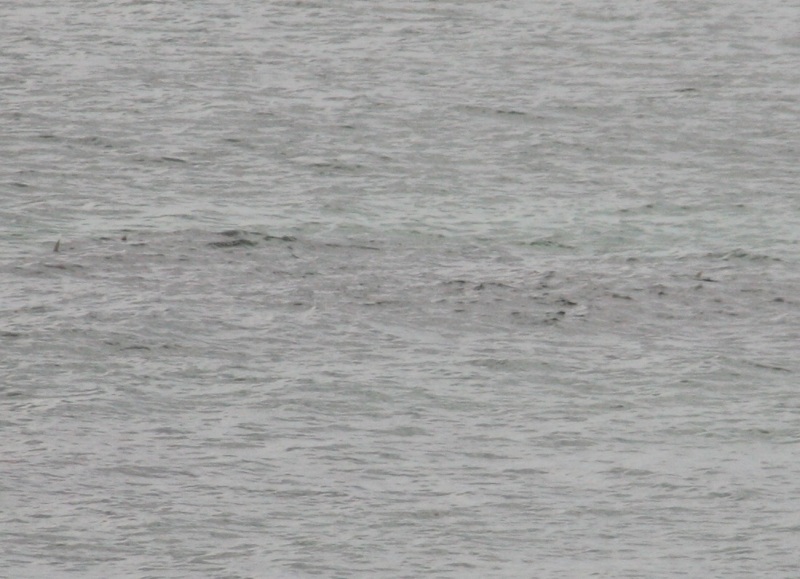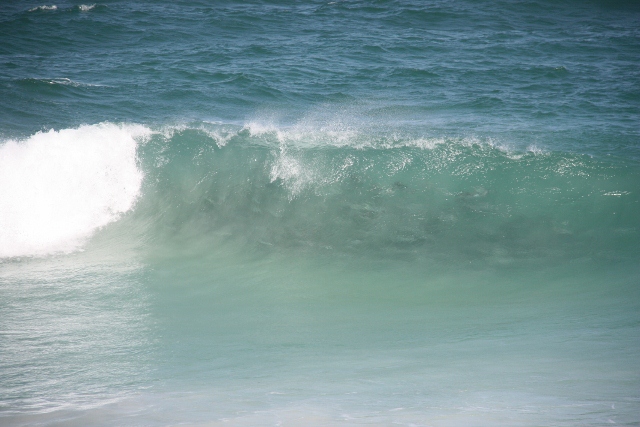last updated 2/12/2019
Australian Salmon are one of the Holy Trinity fish species, along with Barramundi and Mulloway, which makes them a highly prized target. Broad shouldered, chunky, powerful, torpedo shaped fish – one of the best sporting fish within reach of the typical amateur land based fisherman. Their mysterious and unpredictable seasonal migration and schooling behavior makes them an elusive target, further adding to the challenge of catching one of these sought after fish. For the land based angler there are basically two ways to catch Australian Salmon. The first is no different to traditional fishing – hang your bait out in the water with a traditional surf rig and wait for a fish to strike. This is great if there’s no visible salmon schools. The other is to actively chase down schools and throw a lure into the school. This article focuses on the second method. Most information I’ve come across address items like what sort of tackle, what sort of rig, what sort of lure, what time of day, what tide, what is the best spot, etc. The one thing that always seems to be missing is the most important – finding a school. Find a school within casting range and you’ve got a very good chance of landing a salmon. Throw a lure into the school and it’s highly likely you’ll get a hook up.
Together with a friend of mine, I unsuccessfully fished for Australian Salmon for years. We patrolled beaches on the south coast of Western Australia endlessly to no avail. Every Easter, every long weekend in salmon season we’d head down. I began to think the idea of a salmon school was a myth. An urban legend. Huge schools of salmon along our southern beaches every year and I never found one after years of trying? It can’t be true. I recall one salmon mission near Augusta in Western Australia a few years back where we found some salmon frames on the beach. The fillets had been removed and the carcasses were left on the beach. We caught nothing, didn’t even see anything, yet there were these salmon frames sitting there tantalizing us. The next day on the same beach we saw a young lad running up the beach and casting into the water. He claimed to have caught the fish whose frames were left on the beach the day before. As we spoke to him he kept casting and retrieving and running up the beach. He explained he was casting into a salmon school. Right in front of us. “Where is the school” I’d ask. “Right there” he’d say. “Where is it now?” I wondered. “Near where I’m casting” he responded. “Out of casting reach” he reckoned, didn’t hook one up this time. Was this a conspiracy against me? Was the world having a cruel laugh at my expense with these supposed salmon schools that were invisible to me?
The next day we set up base on a small dune overlooking the beach, sat ourselves down with some cold beers and watched the ocean, pondering this salmon conspiracy that the world had wielded against us. Perhaps we had upset the Salmon Gods in some way. Often we’d question whether the Salmon Gods even existed, possibly angering them and provoking them to smite our salmon fishing efforts.
All seemed pretty typical and uneventful sitting on the beach when suddenly we noticed something in the waves. The weather was ideal for salmon spotting – sunny and calm. By chance we were positioned perfectly to observe these glassy waves that were rolling in past a nearby reef and across a deep hole close to shore. Looking into the face of the waves, we could see what looked like the shapes of fish. For a moment we sat in disbelief. Could this be a salmon school? It can’t be. Years of hardship and failure, and for it to come to us so easily whilst we drank beer on the beach? That’s bullshit. We’re hallucinating. Too many beers perhaps.
Before long it could no longer be denied. It was a beautiful Autumn morning and the conditions were perfect for spotting through the water. This was a salmon school. Now it was game on. Peaceful beers by the sea had turned into pandemonium. I wasn’t going to let this one get away after years of trying.
What excitement. My first salmon at my fingertips. Usually I try not to get too wet if it’s cold weather. Although sunny, this was a pretty cold autumn morning in southern WA. But with salmon so close I ran into the surf and started casting and retrieving like never before. Soon after that I’d landed my first salmon. Spotted a school, threw a lure into it and moments later I had it. You may notice in the photo I am wearing only underwear. Boxer shorts. I don’t usually roam around camp in just my undies. I was wearing tracksuit pants before the school was spotted. The school was out deep, just out of casting distance. We had to wade into the water to get that extra distance. No time to put on shorts – I threw off my pants in a fit of salmon madness and headed into the water.
The moral of the story? Learn how to spot schools of Australian Salmon! Preferably before you spend years casting into nothing. The first thing to do is start looking for dark patches beneath the water. That is your job as a salmon fisherman, to scour the water looking for dark patches. They look similar to a large clump of seaweed. In fact it can be difficult to distinguish seaweed from salmon schools, but spotting these dark patches is the first step in finding a school of salmon. Polarized sunglasses help. Make sure you get yourself a good quality pair – mine cost $7.50 including delivery from ebay. I considered getting the $5 set but I would not compromise quality. Once you have spotted a dark patch, there are things to look for that will help identify what that dark patch is. You won’t get a 100% positive ID until you have hooked onto a salmon or snagged some weed, these points below just allow you to make a judgment as to whether to have a cast or not.
Colour: Salmon schools tend to look slightly olive compared to seaweed which tends to look more purple.
Colour uniformity: Seaweed or reef is quite uniform in colour. A school of Australian Salmon is textured. You may not see fish shapes because the fish are too close together, too far away and obscured by the water, but you may see a texture indicative of a school of fish.
Movement: Salmon schools change direction, seaweed or reefs are fixed or drifting slowly in one direction. This sounds like a failsafe method to ID a school, but when you are moving around on the shore and the waves are crashing in and there are no other fixed items to gauge movement, it can be difficult to distinguish a true change in direction. I’ve sworn on a direction change only to reel in a huge clump of seaweed.
Water Surface Texture: A school of salmon swimming near the surface will create a very subtle disturbance to the surface of the water. You cannot see individual ripples or wakes, but it manifests as a patch of slightly different texture on the surface of the water.
Look into the face of incoming waves: This is your best weapon. Looking into a wave face gives you a window to view into the water. It will give you your best chance to view colour and colour uniformity. Sometimes, if the school is close enough, you will actually see fish shapes. Short of that, you may see the blotchy texturing that a collection of distant fish shapes appear as. Without a wave you are looking through the flat surface of the water which has lots of glare and provides no depth to your view. You see only a uniform flat looking colour patch. Waves are the answer.
Fish breach: If you are lucky you may see salmon breach the surface of the water. They could leap out, or you could see just a fin clear the surface. Usually neither.
Other activity: A school of salmon is sometimes accompanied by schools of fleeing bait fish and birds. Usually not though.
Use binoculars: Get a closer look. Not absolutely necessary, but can be helpful.

Here is a school of Australian Salmon. Consider how unremarkable it looks and how easily it could go unnoticed to the untrained eye. Subtle colour, no fish shapes, no colour variation, no activity – very similar to seaweed. I must have overlooked hundreds of these in my years before landing my first salmon.

Here is the same school seen through an incoming wave. Now you can see texture. Even fish shapes. The wave has provided the window through which you can get an idea as to what lies below.

This is the same photo as above but at 100% full crop. The forked tailfins can be clearly seen on some fish.

Here is another school of much larger salmon. Giant Salmon. Wait they’re dolphins, don’t catch them!

This is a photo of a salmon school in overcast conditions. It’s quite difficult to spot. Surface texture gives a subtle clue.

I’ve circled the school here to clarify its position. The only reason this school was spotted on such an overcast day was the very calm conditions. If it was choppy and overcast the school would be nearly impossible to spot.

Here is another shot of the salmon school in overcast conditions zoomed right in so the school covers the whole width of the image. Can you see the fins?
Overcast conditions make it difficult for salmon spotting. Same too for choppy conditions. They both make it difficult to see into the water. In fact that is the reason why I could not see the school even when being pointed to it by the fellow salmon fisherman in the anecdote above. It was an overcast day which made it too difficult for a beginner salmon spotter.
That covers finding schools. What about the rest? Schooling of Australian Salmon is seasonal so you need to try at the right time of the year. They school around Autumn, but there is plenty of variation in the timing and speed of their advance up the coast. All that can be said for certain is that during Autumn there will be schools of salmon distributed somewhere along the south coast of Australia. Keep an eye on fishing reports and feedback from other anglers to give you an idea as to where the schools are at. Salmon prefer surf beaches – you are less likely to find them in sheltered bays, unless there’s stormy weather. Salmon sometimes seek sheltered bays when the swell is up. Salmon schools in large swell also have a tendency to stay out deep, making them impossible to cast to from the beach. What about tackle, moon, tide, time of day, type of lure, retrieval technique, etc? It doesn’t matter much. The main thing to consider is casting distance. Often you find a school that is just out of reach. To maximize casting distance you want to use the longest rod you can find, and with oversized guides which reduce friction as the line spools off the reel. You want the minimum line weight you can get away with, you want your reel to be filled to capacity with line to minimize the amount of lip that the line has to step over. You want to use large solid metal lures like a large twisty or slicer which provide greatest weight for least air resistance.

Big metal lures like these will help maximize your casting distance and are hard for salmon to resist.
If you’re using bait then go for your favourite surf rig with a mullie or pilchard and try to find a deep hole, gutter or pool near the shore where you can cast into. Leave your rig hanging in there and you’ll pick up any rogue salmons swimming about. This is a good technique if you can’t find any schools or if it’s out of schooling season but you need to be persistent. On the far south coast of Australia, on some surf beaches, you can catch salmon most of the year. They won’t be schooling but they’ll be around.
What about eating Australian salmon? They’re a bit chewy, smelly, dry and fishy, especially when grilled. Quite poor eating. Bleed them out and chill them as soon as you catch them and cook them the same day to ensure the best possible outcome. The dark coloured meat is extremely fishy and pungent so cut it out. The taste gets stronger and fishier the more you cook it so try to cook it as little as possible. Cover them with a lid or add some sauce or something to help reduce the dryness. Diluting their flavour by using them as an ingredient in fish balls is a good way to go. They can be ok smoked, probably because smoking is at a much lower temperature than normal cooking which yields less fishy flavours. Similarly preparing them ceviche style (raw fish marinaded in vinegar or lemon juice) yields a milder flavour than cooking. Eaten raw they are much milder and go well with some soy sauce but I’m no expert on the risks of eating raw fish so I can’t recommend doing it. If you are going to eat them raw ensure the gut contents do not make contact with the meat and ensure the meat does not contain little worms.

Australian salmon marinading in chilli and lemon juice. The raw flesh turns white when it reacts with the acid.
I did eat my first salmon catch. Cooked it up on the beach right where we were fishing. I’ll leave you with a photo of the sunset from our beachside camp just after eating the salmon. Needless to say it was a satisfying and memorable camp.
Checkout outbackjoe on facebook
See also:
Our Fishing Setup for Touring / Camping
XXXX Gold – The Great Mystery of the Top End













thanks Mate
My pleasure. Hope it helped you land some huge salmon.
This is truly excellent. I have been trying to catch salmon at Southport beach, South Australia. The other day, I could see a salmon slick, but it was too far to cast out. A bloke next to me couldn’t reach them and he was wearing waders. People say the best time is in the morning around daybreak. Your account explains everything for which I’m grateful.
Hey mate thanks for your feedback, good luck with your salmon hunting. I’ll have to check out southport beach for salmon when our tour around Australia takes us to Adelaide region, probably in a year from now.
If you do, look forward to meeting up. Going back there tomorrow morning, but earlier. Around 8.30am. I’ll see what’s up !
Excellent, informative and enjoyable articles on salmon and mulloway. Seen both caught off Kawana Beach on Sunshine Coast. Yesterday afternoon a bloke, who knew what he was doing, caught and beached a good sized jew, well into schoolie size. He was fishing a gutter with some foam on it for bream using prawns. All this might make me leave the dogs at home and take my beach gear down there. Thanks for the motivation.
When you write about mulloway being illusive do you mean ‘not real, although seeming to be’ or elusive as in ‘hard to find or catch’?
Hey em thanks for your feedback. By illusive I mean hard to catch, with many average Joe fisherman having never caught one. Beyond the reach of average Joe, caught only by hardcore professionals. But not actually hard to catch in terms of skill. Just chuck some bait in a gutter and fish all night.
I think I used wrong word. Will have to fix that. Thanks for lending your English skills!
No worries mate. Thanks for passing on your fishing skills.
Thankyou Soooo much now that I read all of the pages I have been targeting and catching the Australian Salmon of black smith beach in Newcastle NSW I love fighting them I now can’t wate till winter and catch them. A few people thing there bad in eating but my dad marinats them on the fillets yum.
Thanks I’m Jayden 12 years old bye :):P
Buy aunt marys batter mix, remove the red meat keep the white bite size portions, dust with flour, drop them into the batter mix, deep fry for a coupkle of minutes till they float and them eat, really an under rated fish to eat. if done this way they are excellent
Thanks John I’ll give that a go. Most average tasting things end up being pretty good after a batter and deep fry. Worth a try on salmon.
Hey mate I saw your article about how to catch Australia salmon. I am planning to have a try and could you please inform me the locations? Thanks…
Hey Max. Are you in Western Australia? Anywhere on the south west coast during Autumn. The earlier in the season, the further south / east along the south coast you need to go. Poison Creek in Cape Arid National Park is pretty bloody good late summer. Around Easter it’s usually happening around Albany to Dunsborough. Any of the beaches or off the rocks around there. Late in the season up to around Perth. Deepdene beach near Augusta is a favourite for me because you can drive on the beach and I love beach camping. Not many people go there so it feels quite isolated despite being down the road from Augusta. Beach can be pretty boggy though.
Hi Joe, that is so informative and useful. I am in Perth and I have been the Southern coasts of WA many times but I have not known the salmon season before. I will try this Easter. I learn a lot of details about salmon fishing from your article and it must be the textbook for Australia salmon fishing for beginners. Thank you soooo much!
You’re welcome. Good luck!
Salmon? you sure, never seen one, 30years fishing Perth to Albany, bloody urban myth if you ask me. Anyway going to Dunsborough in a few weeks so might buy a few from the shop and chuck on me line so I have something to pull in!
I thought the same for a long time. But once I figured out how to spot schools I was hooked, both literally and metaphorically.
My 7 year old son caught a salmon today on peppermint grove beach south of bunbury.
Nice one, bet he was happy with that.
Excellent reading for me a new newbie. Thanks for sharing.
So many people say Salmon are not good eating but I say they are fantastic to eat when freshly caught and cooked. I feed several families nearly each day on NSW south coast during Jan holidays adults and kids love it.
I fillet and cut into thickish ‘fingers’ fry on hot plate with olive oil, a little salt and lime or lemon juice. For variety I use all sorts of herbs and spices – from curry paste, garlic, cumin seed, coconut cream, fresh herbs, soya sauce and other marinades and experiment with whatever I have. – choice is endless. The hot plate needs to be a gentle simmer heat and not burn – cooked flesh side first and then skin side till the meat just turns white in the centre. Mouth watering!
Hi Ralph my experience with Australian Salmon has been anywhere between ok to quite offensive. Never have I had mouth watering. Guess I’ll have to try harder! I’ll take your tips on board, cheers.
Sometimes I like to marinade salmon in my own poopy and wee wee. Theen eat it raw. Yummy in my tummy. Then I do salmon poops. Yaaaay 🙂
A prodigious body of work here, well done! I particularly admire your dedication to rigorous testing methods and standards applied, where the XXXX evaluation is concerned.
If I may, one point possibly overlooked, which will require extensive testing again to prove/disprove, is inclusion of the use of that well known mobile phone solvent, Aeroguard; I suggest that some of the volatiles used in that formulation, upon contact, may have an enhancing effect with that beer.
Hey Lindsay thanks for the positive feedback. Yeah that research was epic, glad you appreciate it. So that I know what to look for in future experiments, what do you mean be enhancing effect? Does it make XXXX Gold taste better? Or does it improve its intoxicating abilities?
Excellent article. Well worth the read. Excellent photos showing what you mean etc.
Thankyou. Will definitely use your advice to spot em this season.
Salmon bleed prolifically into their flesh once they are caught. Bleed them as soon as you can and you can get plenty of nice clean flesh in the fillet.